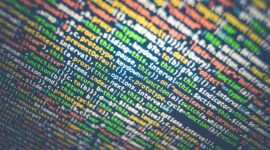The award was in recognition of a simulator that can calculate how initially spherical gas balls deform to merge—or, like Kongas interprets it—how the merging of two white dwarfs occurs. “I chose this topic because I had been studying general relativity for a year or so by myself but it is a very complex subject and I wanted to get a better understanding of what actually goes on,” he explained.
Merging Stars
The model can roughly be divided into two parts: the physical and the computer scientific component. Kongas explained that when one wants to do any useful calculations in physics, it is almost always necessary to make simplifying assumptions. “For example, my model assumed that most of the pressure inside the stars occurs due to the uncertainty principle and not temperature, and this is true for most white dwarfs. Gravity was computed using linearized gravity, a simplified form of general relativity,” he noted.

Kongas brought an example about how his simulator works: “The simulated space is shaped like a large cube inside which the merging occurs. The program first divides this space into many (up to ~7,000,000) small cubes, just as images in computers are often represented as a collection of many tiny pixels. Similar to pixels in images, which store the exact colours of different points in an image, these 3D ʽpixelsʼ in my program store various parameters about the gas and its movement at different points. Then the simulator uses the laws of physics and computes how these parameters stored in the 3D ʽpixelsʼ would change within a very short time. This step is repeated thousands of times until a 3D animation is generated about the merging process.”
New Projects in Progress
He already has new projects that he is working on. One of them is a graph executor, which is not exactly a separate program but a sub-program that could help in doing different sizable calculations.
“This sub-program needs data input and separate sub-programs that could calculate something useful from the data. The results could be necessary for the following calculations. The graph executor can make these calculations in a row or in parallel in several cores, even if the sub-program itself is able to use only one core at a time,” Kongas explained.
The young scientist noted that the executor itself is actually quite an easy tool but it had its tricky parts as well. “The most difficult part of the graph executor is choosing the sub-programs that should start work subsequently so that the work would be done quickly and smoothly with a large number of processor cores,” Kongas said.
Kongas explained that it is often relatively easy to program calculations and the connections between them but sharing the activity effectively between different cores can be much more complicated, and it would be much easier if the graph executor could do this job.
Time will tell About The Future
The young man has been programming computer simulations for a long time because he likes both programming and physics. “I was in 6th grade when I wrote my first interesting simulation. It calculated the trajectories of interacting charged particles, which elastically bounced off of each other. I called them atoms,” Kongas said.
For him, programming has always been both business and pleasure. “On the one hand, programming such simulations requires a thorough comprehension of the physics you are trying to teach the computer, forcing you to correct any flaws in your understanding. On the other hand, once you finally have a working simulation, it’s almost impossible to resist the temptation to play with it, giving you a better intuition about how the simulated physical process actually happens,” he mentioned.
Kongas does not exactly know what he will do next fall because he likes physics, mathematics and computer science but he is not sure if researching as a main job is what he dreams of. “Publishing a single scientific article takes a lot of time, and it is necessary to compete for grants to fund one’s projects. Naturally, this does not mean that I won’t publish some articles or projects if they turn out to be significant,” he concluded.
This article was funded by the European Regional Development Fund through Estonian Research Council.
 Back
Back


